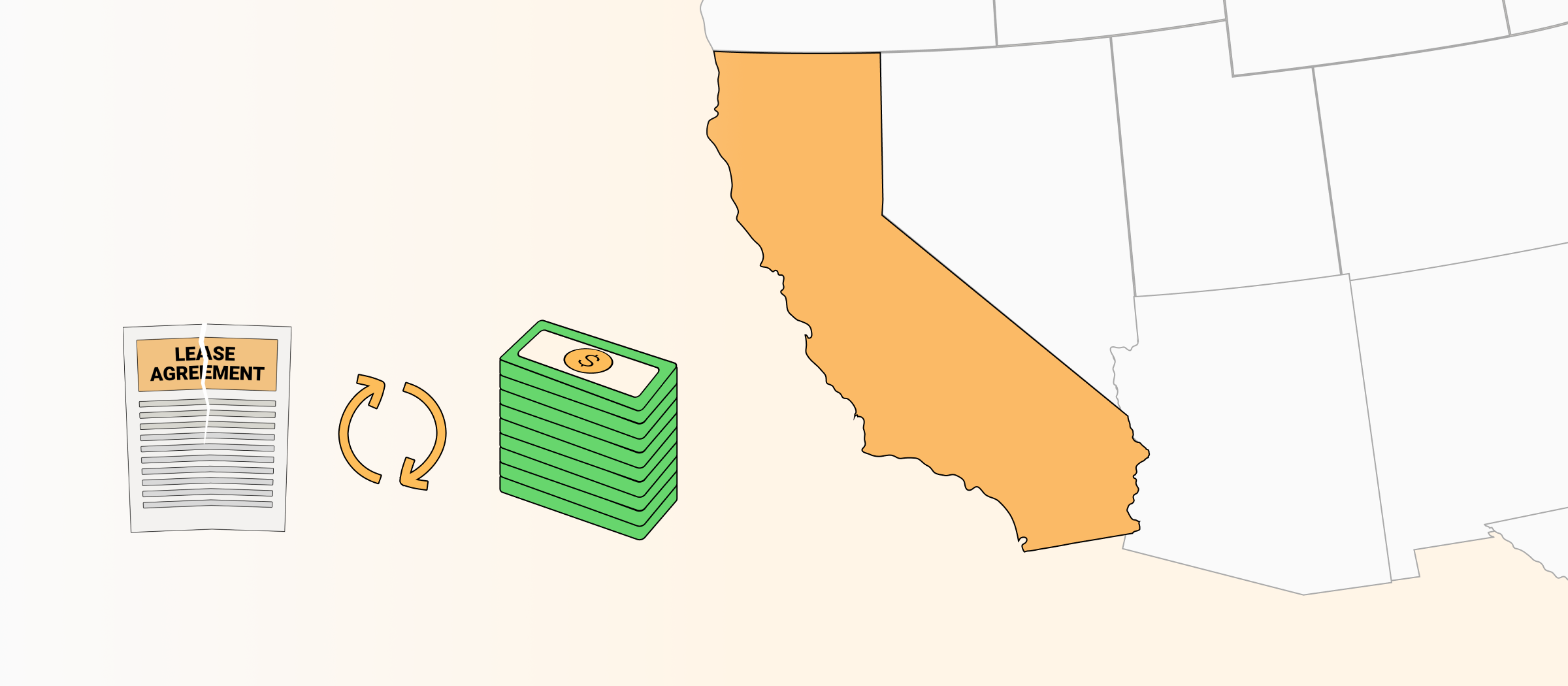In California, tenants that break their lease early may be held liable for all remaining rent due and any property damage. In addition, landlords in California are not required to make reasonable efforts to re-rent and may still be able to charge the old tenant when a new tenant cannot be found.
Breaking a Lease Early Without Penalty in California
In California, a tenant may break a lease without penalty under the following circumstances:
- Violations of the implied warranty of habitability
- Early termination clause
- Permanent change in military station resulting in relocation
- Harassment or violations of the tenant’s privacy
- Refusal to reasonably accommodate a tenant with physical or mental disability
- Unenforceable, illegal, or void lease
- Domestic or sexual violence
- Retaliation against the tenant for requesting a repair or reporting to a government entity
- Death of the sole tenant
In California, a landlord can charge an early termination fee if the tenant breaks a lease early, but it must be written into the contract along with the terms. For example, a landlord may require 30-days’ notice and 2 months’ rent in order to break the lease early.
How Much Remaining Rent Could Tenants Owe in California?
California does not have a law limiting the amount a tenant owes a landlord when breaking a lease early. A tenant could be liable for the remaining rent through the life of the lease. However, a landlord must mitigate damages and seek to replace the tenant.
Landlord’s Duty to Mitigate Damages in California
In California, a landlord must make a reasonable effort to re-rent their unit when a renter has broken a lease early. If the landlord is able to find a new renter, the original occupant who broke the lease no longer has to make rental payments. This is called a landlord’s duty to “mitigate damages .”
Although the law gives no definition of what reasonable effort means when re-renting the unit, some examples include:
- The landlord must prepare the property for a new tenant in the same way they would as if they were between leases
- The landlord must advertise the rental vacancy
However, if a landlord cannot find a new tenant, the prior tenant is still liable for the remaining rent owed under their lease.
A landlord is not required to fill the unit with any tenant who wants to move in. The landlord is allowed to apply the same standards that they apply to all rental applications, such as having sufficient income to cover rent.
Tenant’s Right to Sublet in California
A tenant can legally sublet in California, but only with the explicit permission of the landlord. Unless the lease states otherwise, a tenant’s right to sublease is contingent upon receiving the landlord’s written consent.
Even though a tenant might have permission to sublet, the landlord retains the right to reject a prospective tenant. Reasons for rejection might include the subtenant being financially unable to make the lease payments.
If a tenant subleases their unit without the landlord’s explicit written permission, the tenant is in breach of the lease. In California, a lease violation permits a landlord to evict the tenant and subtenant (starting with a 3 Day Notice to Comply or Vacate) and to sue the original tenant for any resulting damages.
In addition, the subtenant also may have grounds to take legal action if the original tenant sublet the unit without the landlord’s permission.
Consequences for Moving Out Early in California
If a tenant breaks their lease and moves out early, the potential consequences include:
- The landlord keeping the security deposit
- The landlord suing the tenant for damages
- A lower credit score
- A potential bad reference in the future
Can the Landlord Keep the Security Deposit?
If a tenant breaks a lease early, a landlord can keep all or part of the security deposit. The amount kept by the landlord depends on how much the tenant still owes in damages and the remaining rent.
When a tenant breaks a lease early, the landlord can deduct from the deposit the amount of rent the landlord loses until a new tenant starts paying. If the owed rent becomes larger than the amount of the security deposit, then the landlord can hold the tenant liable for the difference—assuming the landlord has made a reasonable effort to re-rent the unit.
Similarly, a landlord can deduct from the deposit any property-related costs such as damage the tenant caused to the premises. These damages need to be caused by the tenant’s negligence or carelessness rather than from normal wear and tear.
Can the Tenant Be Sued for Damages?
If a tenant breaks a lease early in California, the landlord can sue a tenant for a breach of contract for the remaining rent due or for any property damage. Damages for less than $10,000 are considered “small claims” in California and should be filed in the California Small Claims Court.
If a landlord files in Small Claims Court, they cannot bring a claim for more than $10,000. If suing for damages greater than $10,000, a landlord can file a claim in the Circuit Court for the county in which they live.
Sources
- 1 CA. Civ. Code § 1951.2
-
The landlord may recover damages only if they relet the property prior to the time of award and proves that in reletting the property, he acted reasonably and in good-faith effort to mitigate the damages.
Source Link

